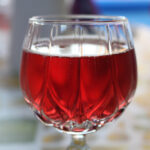Poor Lambrusco! So misunderstood!
In America, that is.
In northern Italy, where Lambrusco is made, Italians guzzle untold gallons of this stuff with food. For many Italians, it is the go-to wine, the wine you can always count on with meals.
Here in the U.S., it mostly provokes judgmental frowns.
So how did the Lambrusco Gap come about?
Lambrusco is a very old wine in Italy, many versions of which have been enjoyed there since the time of the Ancient Romans! It’s most traditional in its homeland, the Emilia-Romagna region of Italy, a wide swath of picturesque land that runs from the Adriatic Sea to the Apennine Mountains to the River Po at the top of The Boot. This status is nothing to sneeze at. Most Italians agree that Emilia-Romagna has the best food in Italy as it is the home of prosciutto di Parma, Parmigiano-Reggiano, balsamic vinegar, etc. It’s very common for the locals to drink Lambrusco with their hearty cuisine. But the Lambrusco they drink is mostly red, fizzy, and impeccably dry.
 A Lambrusco vineyard near Modena, just after harvest
A Lambrusco vineyard near Modena, just after harvest
Here’s the cognitive dissonance: when Riunite decided to make a big Lambrusco push in the U.S., back in the 1960s and ‘70s, they focused on the relatively rare, definitely unrespected, sweet Lambrusco. “Perfect for Americans,” they thought. Some of us remember the madness: “chill a Cella,” “Riunite on ice, so nice,” and on and on. To add insult to injury, the quality of the Lambrusco they were selling was low; this was the cheap plonk.
If you’re an American who came of age around that time, your memory of Lambrusco is a dismal one. But those Americans born in the ‘70s, ‘80s, or ‘90s likely don’t know what Lambrusco is! Neither hand is a winning one for the exporters/importers of Lambrusco.
 Tortellini, classic Emilia-Romagna food for Lambrusco
Tortellini, classic Emilia-Romagna food for Lambrusco
Moreover, the variety of Lambrusco wines is astonishing, with many of them offering complex flavors and striking textures. Most Americans who know the subject a little bit don’t realize that there are 60 different grape varieties that can go into the production of Lambrusco! And a bevy of denominaziones to support them. For example, the DOC Lambrusco Grasparossa di Castelvetro is the famous dry, full-bodied Lambrusco grown south of Modena, very dark in color, based on the Lambrusco Grasparossa di Castelvetro grape. The DOC Lambrusco di Sorbara is also a famous Lambrusco, grown north of Modena, very light in color, tends to be more acidic on the palate, and based on the Lambrusco di Sorbara grape. Wow!
 Sorbara to the left, Grasparossa di Castelvetro to the right
Sorbara to the left, Grasparossa di Castelvetro to the right
But dark or light, the category is fizzy, mostly red, and exquisite with food.
Tomorrow, I will share with you details about one of my favorite Lambrusco wines in the U.S. market. It comes from the Cantina di Sorbara, a 100-year-old cooperative of over 1,600 small growers in the Modena region (smack-dab in the middle of Emilia-Romagna), and I have the perfect Italian dish to go with it.
images: Caspar Diederik/Flickr Creative Commons & David Rosengarten



